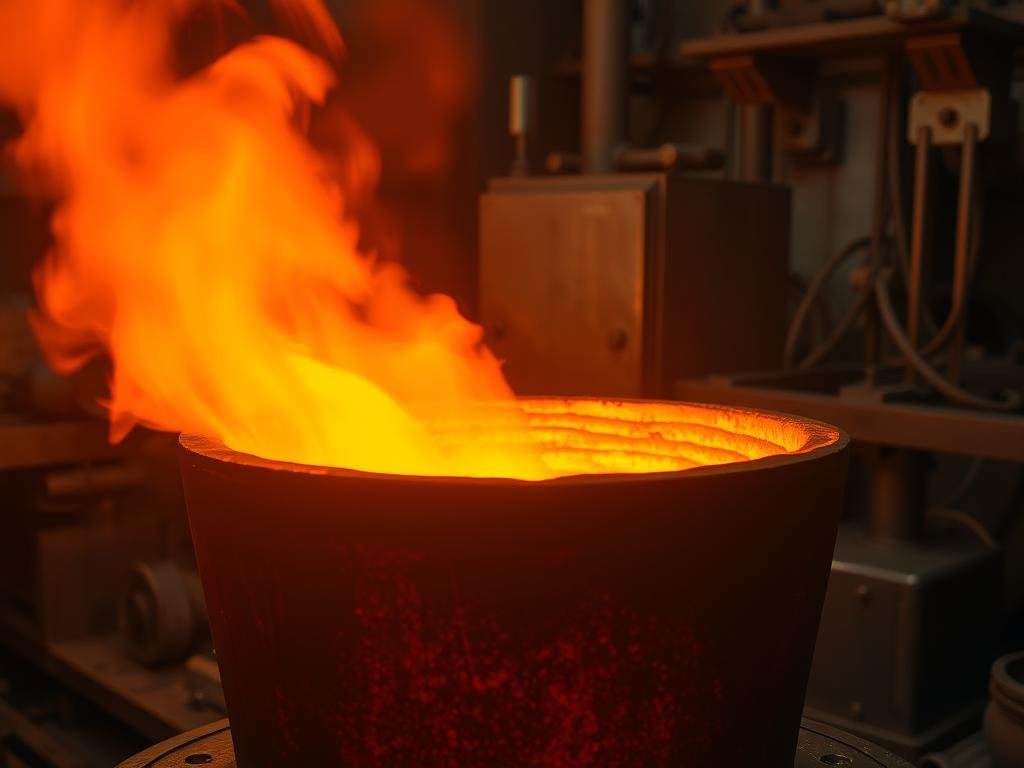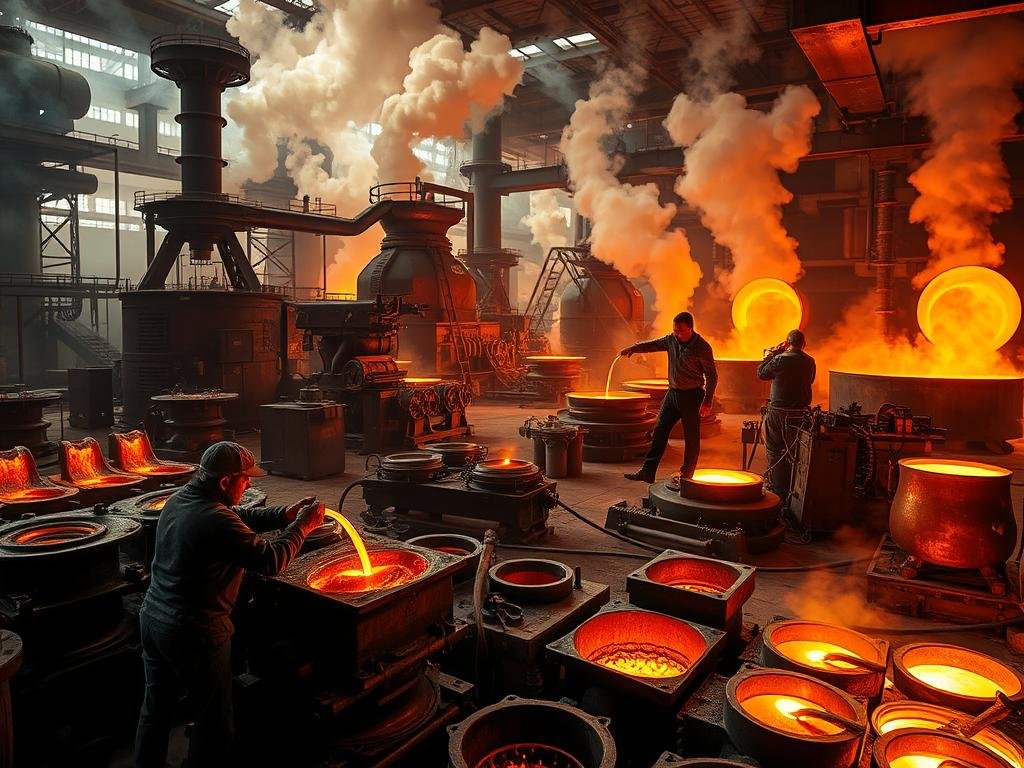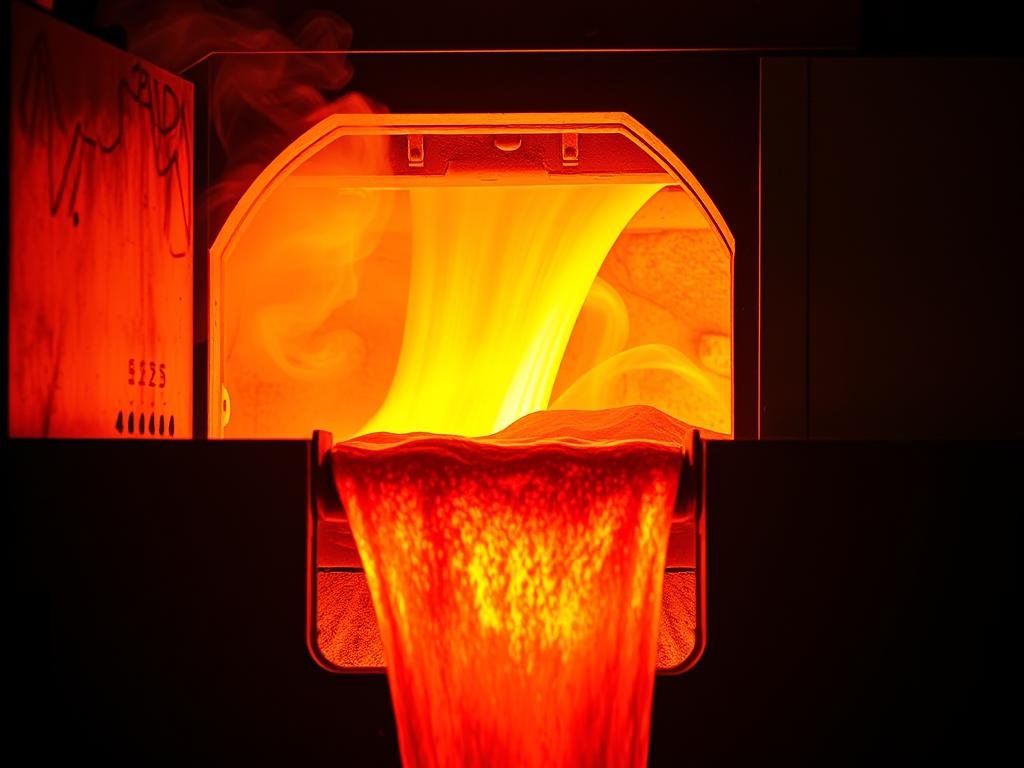Surprising fact: many shop furnaces must reach more than 2800°F to turn common structural metal into liquid, a temperature that demands robust equipment and strict safety controls.
This guide explains that transition temperature and why it matters for CNC work, casting, and heat treatment. Knowing this fusion mark helps teams choose furnaces, tooling, and fixtures that offer enough thermal headroom to avoid part failure.
For quick context, representative values place iron at about 2800°F (1538°C), with neighboring alloys like stainless steel and nickel close behind. Thermal conductivity and expansion tie directly to those numbers and shape tolerances, cycle time, and finish goals.
With over 15 years of experience, Rapidaccu applies material-appropriate thermal strategies from prototype to mass production, ensuring quality and precision across processes.
Want a detailed temperature table and comparisons? See this practical reference on melting data for shop planning: melting point reference.
Defining the melting point and why it matters in metals
A precise thermal benchmark helps engineers plan safe process windows and keep parts within tolerance during high-heat work. Understanding that benchmark prevents furnace overshoot, component failure, and wasted cycles.
What “melting point” means in metallurgy
In metallurgy, the melting point marks the temperature where solid and liquid phases coexist at equilibrium. That single number gives design and process teams a clear safety margin for equipment and fixtures.
Melting differs from softening. Parts lose strength well before reaching that transition, so conservative limits matter for machining and welding.
Thermal conductivity and thermal expansion connections
Thermal conductivity measures how fast heat moves through a metal. High-conductivity alloys heat and cool quicker, which affects tool life and thermal gradients during CNC work.
- Thermal expansion changes length and volume as temperatures rise, risking distortion and tolerance loss.
- Phase changes in structure can alter properties long before full melting occurs.
- Rapidaccu uses material-specific thermal data to set cutting speeds, coolant strategy, and fixturing for repeatable surface finish.
| Property | Effect | Manufacturing implication |
|---|---|---|
| Thermal conductivity | Heat flow rate | Tool wear, cycle time |
| Thermal expansion | Dimensional change | Fixturing, tolerances |
| Phase transformations | Microstructure shifts | Strength, finish |
Whats is the iron melting point
A clear numeric benchmark helps teams set safe furnace setpoints and avoid costly errors.
Pure iron reaches about 1538°C (≈2800°F). This value serves as a baseline for process planning and safety in fabrication and casting.
Alloying and carbon shift that baseline. Many steels, cast irons, and stainless grades melt at different ranges, so use the pure value as a controlled reference.
- Use the numeric value to set furnace setpoints and preheat sequences.
- Expect high energy demand and robust thermal protection for tooling and fixtures.
- Design margins matter: strength drops well before the melting temperature.
- Maintain tight monitoring and control to preserve repeatability and part integrity.
| Item | Why it matters | Manufacturing action |
|---|---|---|
| 1538°C baseline | Common language for teams | Use for setpoints and QA |
| Alloy shifts | Changes melt behavior | Adjust process windows |
| Thermal loss | Strength reduces before melt | Set conservative margins |
Rapidaccu engineers reference authoritative melting data when tuning heat-adjacent steps. For practical numeric comparisons and shop planning, consult this melting data resource: melting point reference.
Iron vs. steel vs. cast iron vs. stainless steel: temperature benchmarks
Comparing benchmark temperatures across common ferrous and nonferrous metals helps shops choose the right furnace and refractory. Rapidaccu uses these values to advise material choice, tooling, and cycle planning.

Pure iron baseline
Pure iron sits near 1538°C (about 2800°F) and serves as a high-baseline reference. Many steels fall slightly below that mark, while some stainless grades track close to it.
Cast iron and carbon effects
Cast iron typically melts around 1204°C (≈2200°F). Higher carbon lowers fusion temperature via eutectic behavior in Fe–C systems, so cast parts often need different mold materials and heat schedules.
Steel, stainless, nickel and wrought iron
Low-alloy steels cluster near 1371°C (≈2500°F). Stainless alloys often range toward 1510°C (≈2750°F), but austenitic 304 may melt near 1400–1450°C. Nickel and wrought iron sit between these values and pure iron.
| Material | Approx. °F | Approx. °C |
|---|---|---|
| Pure iron | 2800 | 1538 |
| Cast iron | 2200 | 1204 |
| Steel (carbon/low-alloy) | 2500 | 1371 |
| Stainless steel (general) | 2750 | 1510 |
Chromium, nickel and other alloying elements shift these temperatures. For practical shop planning and a compact reference, see this melting point reference.
Factors that change the melting point of iron and its alloys
Practical shop decisions hinge on how composition, pressure, and cooling alter thermal thresholds. Small shifts in chemistry or service environments can move a melting point iron baseline enough to change process limits.
Carbon, alloying, and purity
Higher carbon lowers fusion behavior, which explains why cast parts with more carbon show lower melting than many steels. That lower melting effect also makes cast materials behave differently during foundry and welding steps.
Alloys such as chromium and nickel change phase diagrams and widen processing windows. Fewer impurities typically raise predictability and marginally raise melting values, improving control during thermal cycles.
Crystal structure and pressure
Structure shifts, like BCC to FCC transitions, change mechanical response long before bulk fusion occurs. Pressure raises thresholds in controlled applications, giving extra margin in high‑stress processing.
Cooling rate, defects, and service environments
Rapid quench can trap metastable microstructures and alter later heat response. Defects, residual stress, and harsh environments can locally reduce resistance to heat and accelerate degradation near hot spots.
- Welding: adjust preheat and interpass controls to avoid heat‑affected failures.
- Machining: set conservative thermal limits when composition varies between batches.
- Example: a medium‑carbon steel balances machinability against thermal margin; added nickel improves toughness but shifts processing temperatures.
| Factor | Effect | Manufacturing action |
|---|---|---|
| Carbon content | Lower melting range | Use cast‑specific molds and lower weld temps |
| Alloying elements | Shift phase equilibria | Adjust heat schedules and tool selection |
| Purity & defects | Predictability changes | Batch testing and conservative setpoints |
Rapidaccu accounts for composition, purity, and environments when recommending machining and finishing strategies. That approach protects dimensional accuracy and surface finish during production runs.
From ore to molten iron: smelting, pig iron, and steelmaking temperatures
From coarse ore to a tapped melt, upstream steelmaking shapes the thermal and chemical profile machinists see later.
Blast furnaces charge iron ore, coke, and limestone. Heat exceeds 2000°C as coke reduces ore to metal and fluxed limestone forms slag that traps impurities.
Pig iron is tapped from the furnace and separated from slag. That molten metal then moves to converters where oxygen lowers excess carbon to make cleaner steel.
Electric arc routes and refining
Electric arc furnaces melt scrap or selected ore blends. Arc power lets operators control melting temperature and chemistry with precision.
- Blast furnace charge: ore, coke, limestone yields molten bath and slag removal.
- Pig iron tapping and oxygen refining remove carbon and adjust composition for casting or steelmaking.
- Arc furnaces use scrap for flexible chemistry and tight temperature control.
- Accurate temperature measurement matters during refining to hit final specs.
| Stage | Typical temp | Key outcome |
|---|---|---|
| Blast furnace | >2000°C | Molten bath, pig iron tapped |
| Converter refining | Controlled high | Lower carbon, cleaner steel |
| Electric arc | Precisely controlled | Flexible chemistry from scrap |
Rapidaccu links material provenance and process choices to machining strategy. Tracking ore quality, scrap blends, and carbon content improves consistency in casting, machinability, and dimensional stability.
Process implications: casting, welding, and heat-based manufacturing
Choosing equipment with sufficient thermal margin prevents costly rework and preserves part geometry during casting and welding.

Selecting furnaces and tools with higher melting points than the workpiece
For casting, select refractories, crucibles, and tooling that tolerate higher melting and repeated cycles. This avoids contamination and premature failure.
Furnace linings and mold materials must exceed the target melting point and handle thermal shock. Rapidaccu specifies extra headroom to protect surface finish and tooling life.
Welding near-melting temperatures and joint integrity
Welding deliberately approaches the melting point to fuse metals. Precise heat input, controlled temperatures, and correct filler metals ensure strong, defect-free joints.
For steel parts, preheat and interpass settings reduce residual stress and cracking. Monitor energy to avoid overheating thin sections and distorting geometry.
- Choose furnaces and tooling with higher melting and thermal stability than the workpiece.
- Use mold and crucible materials that tolerate repeated cycles and high melting temperatures.
- Control welding heat input, select compatible filler metals and gases, and set preheat/interpass for steel.
- Fixture, insulate, and shield adjacent features to limit distortion and protect surface finish.
- Plan conservative process windows from known melting point data to meet throughput without compromising quality.
| Control | Action | Outcome |
|---|---|---|
| Furnace selection | Higher melting refractory | Reduced contamination, longer life |
| Weld procedure | Heat control and filler choice | Consistent joint strength |
| Fixturing | Insulation and restraint | Lower distortion, stable geometry |
Finally, verify results with NDT, dimensional checks, and surface inspection tied to the heat profile used. Rapidaccu builds process windows that keep material properties consistent while meeting production targets for metals work.
Practical temperature guide: common metal melting points for manufacturing
Use this compact temperature ladder to pick materials and furnace settings with confidence.
Lower to higher melting points: aluminum through copper alloys
Start low when planning castings or brazing. Aluminum sits near 1218°F (659°C), though alloys span 453–666°C.
Brass melts around 1700°F (927°C), and typical bronze near 1675°F (913°C). Copper follows at roughly 1981°F (1083°C).
Iron family and beyond: cast iron to tungsten
For ferrous benchmarks, cast iron is about 2200°F (1204°C), steel roughly 2500°F (1371°C), and stainless steel near 2750°F (1510°C).
Nickel and wrought forms sit between 2646–2700°F (1452–1482°C). Pure iron reaches ~2800°F (1538°C). At the extreme, tungsten tops the list near 6150°F (3399°C).
- Use this ladder as a quick-selection tool when choosing furnaces, crucibles, and refractories.
- Remember alloy composition shifts these temperatures; validate grade-specific data before production.
- Document routed temperatures to aid fixture design, coolant strategy, and sequencing for assemblies with mixed metals.
| Material | Approx. °F | Approx. °C |
|---|---|---|
| Aluminum (and alloys) | 1218 (453–666 for alloys) | 659 (453–666) |
| Copper, brass, bronze | 1981 / 1700 / 1675 | 1083 / 927 / 913 |
| Cast iron, steel, stainless | 2200 / 2500 / 2750 | 1204 / 1371 / 1510 |
| Nickel, wrought, iron, tungsten | 2646 / 2700 / 2800 / 6150 | 1452 / 1482 / 1538 / 3399 |
Rapidaccu supplies verified melting data to align machining parameters and heat management with real material behavior. Use this guide as an example baseline and confirm specs per alloy before machining or fabrication.
How Rapidaccu’s 15+ years in CNC manufacturing leverage melting point knowledge
Rapidaccu turns thermal science into practical machining rules that improve part accuracy and finish.
Material selection for precision CNC plastic and metal machining
We combine melting data with mechanical property charts to advise on material choice for plastics and metals. This approach keeps machining programs within safe thermal limits and preserves surface quality.
From prototypes to mass production: accuracy, surface finish, and heat considerations
Prototype runs validate feeds, speeds, coolant strategy, and tool coatings. After validation, documented settings scale to production with repeatable results and consistent quality.
- Fixture design and toolpath sequencing reduce local heating and maintain tight tolerances.
- Casting-ready parts receive plans that account for prior thermal histories and service environments.
- We work with supply chains tied to converter and electric arc scrap metallurgy to set realistic expectations on composition and machinability.
| Focus | Action | Outcome |
|---|---|---|
| Materials & alloys | Grade selection, test cuts | Predictable finish, fewer rejects |
| Process params | Feeds, coolant, coatings | Protected geometry, longer tool life |
| Inspection | In-line and post-process checks | Verified geometry and surface quality |
Contact us early in design to align materials, manufacturing goals, and cost while accounting for point iron concerns and heat management.
Conclusion
Good temperature planning turns metallurgical data into reliable production outcomes.
An iron melting point near 2800°F (1538°C) anchors process planning for ferrous work. Carbon lowers fusion ranges while alloying with nickel and chromium shifts behavior within a material’s structure.
From ore to molten iron and pig iron to steel, controlled temperatures matter at every stage. Allow safe margins below melting point and plan for higher melting or lower melting tendencies when choosing furnaces, tooling, and fixtures.
Accurate control, monitoring, and cooling schedules keep shape and properties stable. Document melting-related constraints in routings, weld procedures, and inspections.
Rapidaccu pairs deep material knowledge with precision CNC capability to convert this guide into consistent quality from prototype to production. Contact us early to align design, materials, and process with thermal realities.

